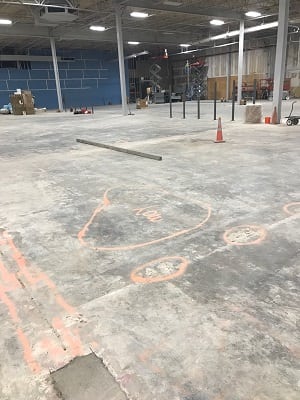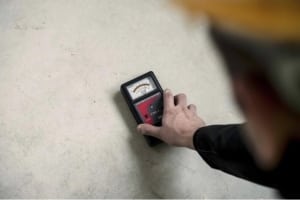Is your concrete slab ready for your new sports floor? Here are some tips to ensure quality from the ground up!
They say beauty is only skin deep. That goes for flooring, too. It doesn’t matter if you have the most magnificent maple or a simply stunning synthetic – looks mean nothing if what’s underneath is ugly.
The foundation of any flooring is critical. Without the proper base, a floor, no matter how aesthetically amazing, will incur problems, not perform well, be a safety hazard for users, and will need to be replaced well before it should, costing more money in the long run.
Concrete plays a significant role in the sports flooring industry due to the majority of sports floors – both hardwood and synthetic – being installed over concrete. While concrete can provide a good solid surface for flooring, it can also be a detriment if not installed properly. If not completely cured or dried or if leveled improperly, the quality of the sports floor can be affected greatly and cause delays in your project or require major repairs for an existing floor.
Robbins, the sports flooring specialist, knows concrete inside and out and is dedicated to ensuring your project is a success, standing by their product, workmanship and installation from top to bottom.
“When we are installing a system, the expectation of that system is that it is going to last and last,” said Lisa Szczupaj, Robbins account manager at Sika USA, owner of the Sika Netherlands manufacturing plant, producer of Robbins Pulastic synthetic sports floor systems. “From the bottom up you want to ensure that everything about the installation of the system is built in a way that it is going to last a lifetime – 25 years plus without any issues. If it starts letting go at the slab you’ve got a problem from the bottom up that sacrifices your system ultimately.”
Why is moisture in concrete so important?
Szczupaj, an expert in the chemical composition of concrete, says that a major culprit in faulty concrete substrate is moisture content within the concrete.
Concrete mix design is of utmost importance when building a slab to ensure longevity. The concrete mix design is the process of selecting appropriate ingredients and their proportions for a concrete mixture.
“Part of what comes with that is using the right amount of water in the mix,” Szczupaj said. “Mixing concrete is just like making a cake. You don’t want too much liquid but if you don’t put enough it’s not going to turn out, so there’s a sweet spot.”
For a fluid applied urethane product like Pulastic, Szczupaj said moisture levels in the slab can affect adhesion. Urethane, by nature, reacts with moisture, so minimizing the moisture that comes into contact during application and cure of the product is important for the floor to stay put, according to Szczupaj.
And it’s widely understood that moisture negatively affects wood. Typically, wood floors are floating systems that do not seal off the slab, rather the wood lives off the ambient conditions that are caused by the environment, Szczupaj said. For instance, a concrete floor that’s not sealed has a high level of moisture, so the gap between the slab and the maple floor built on top could have a potentially damaging amount of relative humidity. While wood naturally expands and contracts, excess moisture can cause wood to be pushed beyond its limits, resulting in buckling, warping and splintering. It can also result in mildew or mold growth.
Causes of moisture problems
- Leaks – busted pipes, ceiling leaks, roof leaks.
- Major flooding, natural disasters.
- High humidity or drastic environmental changes.
- No moisture barrier or a faulty barrier installed beneath the concrete slab.
- Alkali-silica reactions.
- Improper curing or drying time for concrete.
Solving moisture problems
- Prevent leaks with regular maintenance and inspections. Any type of top-down moisture can wreak havoc, with wood floors in particular.
- When major fluctuations in humidity exist in a facility, flooring systems can suffer. Pulastic tends to hold up better than wood, regardless, controlling the environment is critical. “It’s very important that the environment is in what you would call “at-use” conditions,” Szczupaj said. “If you’re in a new construction situation, you don’t want to install a floor before the point that the heating and air conditioning goes live. You want the environment to be stable and you want it to be what the day-to -day environment will be when that floor is in use. Making sure that the facility is in at-use conditions prior to the installation is one of the best ways to ensure a quality, long-lasting floor installation.”
- If a high level of slab relative humidity exists, an epoxy or cementitious urethane can be applied to the slab as a moisture barrier for Pulastic systems. For wood systems, Robbins uses a
 VersaShield® Moisture Suppression System for situations with high concrete moisture.
VersaShield® Moisture Suppression System for situations with high concrete moisture. - Make sure a 10 mil impermeable plastic liner beneath the concrete slab is installed to prevent ground moisture from coming up through the slab. If that liner is not present or is faulty, mold or mildew can result and create pressure underneath the flooring system, allowing pockets of moisture to rise.
- Ensure the proper concrete mix is utilized, and minimize moisture in the slab. When highly alkaline concrete mix reacts with moisture and silica present in the aggregate, an alkali-silica gel results. The gel will cause the concrete to fail, as the floor pops off or adhesion issues arise.
- Allow the concrete to properly dry or cure. Cure time and moisture are positively correlated. Sometimes contractors give cure rates as 30 days per inch of slab, but that’s not about the concrete drying or curing off or moisture being released, according to Szczupaj. “In our industry we basically say it’s not about time,” Szczupaj explained. “It’s about the current state of the slab.” Szczupaj said to steer clear of anyone who quotes any hard and fast rules associated with curing time. Many factors, including ambient and exterior conditions come into play. Robbins relies on a Tramex moisture meter for accurate results. While Robbins always operates in the most timely manner, they will never skimp on quality to rush a job.
Properly installing a flooring system can be detailed, labor-intensive and often times challenging right down to the concrete. Robbins prioritizes doing what’s right for your project to ensure longevity and quality, beginning even before the flooring system is installed.


